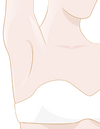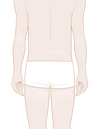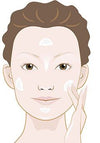Ingrown hair – what is it?
An ingrown hair is a hair that grows inward because it cannot penetrate the skin or because it is forced back into the skin. Ingrown hairs can occur anywhere on the body and face where there is hair. Both men and women can experience ingrown hairs.
The problem arises especially after shaving, which is why men most often struggle with ingrown hairs on the face and neck, while women especially experience the problem when shaving legs, armpits and intimate areas.
However, ingrown hairs can also be associated with friction or pressure, for example if you wear very tight clothing. It could be tight jeans or the elasticated edge of a pair of nylon stockings. In addition, people with curly hair and men with a lot of body hair are said to have a higher tendency to develop ingrown hairs.
An ingrown hair is not dangerous, but it doesn’t look pretty. It begins as a bump on the skin that can cause redness, burning and itching. Often it resembles, and may be confused with, a pimple. It is annoying, especially when it occurs in visible places.
In fact, untreated ingrown hairs can also develop into an infected, inflamed and painful pimple or abscess in the skin. Therefore, there are many good reasons to make sure you treat your ingrown hair – and do everything to prevent them from occurring in the first place.
What are causes ingrown hairs?
When a new hair is formed in a hair follicle, it will usually grow up and penetrate the skin. But if something blocks the hair from growing straight upwards, it will instead grow sideways under the skin, becoming an ingrown hair. It may be dead skin cells, for example that prevent your hair from growing up through the skin.
An ingrown hair can also occur by forcing the tip of an adult hair back into the skin or into the hair follicle from which it came. This happen, for example, from the pressure of tight-fitting clothing or after shaving.
Ingrown hairs after shaving
Shaving is tough for your skin. Often the body unfortunately reacts to the harsh treatment with burning, itching, red buds, razor burn and ingrown hairs.
Shaving is the most common cause of ingrown hairs. You can get ingrown hair wherever you shave – on your face and legs, under yours arms, on your back, in your intimate areas and anywhere else on the body.
The symptoms may look similar, but ingrown hairs and razor bumps with red buds are not the same, nor are the causes the same.
ALSO READ: Remedy for razor bumps
Razor bumps occur when a bacterial infection and subsequent inflammation happen in a hair follicle. The red buds, which are the visible sign of razor bumps, can develop into pimples or blisters filled with inflamed pus. These pus bumps are also called furuncles. In the worst case scenario, they can develop into real boils. Typically, it is the bacteria staphylococci or streptococci that cause inflammation.
However, as mentioned above, the cause of ingrown hairs is simply that the hair grows under the skin because it is forced back under. The symptom of an ingrown hair can be the same as that of razor bumps: a red bud that is irritated, stinging and itching. And the bud can later turn into an inflamed pimple or abscess.
Ingrown hairs due to tight clothing
When the tip of an adult hair is forced back into the skin or into the hair follicle from which it came, it may be due to the pressure of tight-fitting clothing. It can be tight jeans or the elastic of a pair of nylon socks that constantly press against the skin, thereby preventing the hair from growing freely.
The problem of ingrown hairs arises especially after shaving – tight-fitting clothing will only increase the risk of ingrown hairs. It is therefore a good idea to avoid tight jeans or tight elasticated underwear and socks on the first day after shaving or wax hair removal.
Ingrown hairs that do not grow out
An ingrown hair can occur because the hair is blocked so it never reaches the surface of your skin. When the hair is ‘trapped’ below the skin’s surface, it will grow further under the skin, creating an inflamed spot.
This phenomenon – where an ingrown hair has not occurred due to shaving – can occur anywhere but is especially common on men with thick hair between the buttocks. The ingrown hair forms a fluid-filled cavity (a cyst). When the cyst becomes infected with bacteria, a red and painful abscess is formed. The cyst is called a pilonidal cyst and is seen between the buttocks and the rectum. It may be necessary to remove the cyst with surgery.
How to treat ingrown hair
The best treatment for an ingrown hair is to make sure it does not occur. But if you already have ingrown hairs, fortunately there are some good ways to treat it, so you get rid of it.
Here’s how to remove an ingrown hair:
The best treatment for an ingrown hair is to make sure it does not occur. But if you already have ingrown hairs, fortunately there are some good ways to treat it, so you get rid of it.
Step 1. Begin by gently exfoliating the area where the ingrown hair is located. Exfoliation removes sebum, grease, dirt, dead skin cells, and other things that can make the skin clogged. You can use an exfoliating cream and possibly supplement it with a scrub glove. One product that is suitable for combating ingrown hair with antibacterial ingredients is the Australian Bodycare Body Scrub. The Body Scrub removes dead skin cells as well as preventing ingrown hairs.
Step 2. Soak and warm the skin with a warm and moist towel pressed on the area where the ingrown hair is. For example, you can use a flannel rinsed in warm water and then twisted. You can also soften the skin by taking a warm bath.
Step 3. Gently remove the hair using sterile tweezers or a needle. When the skin is softened and warm, the hair should come up to the surface and be more visible. Do not dig for the hair as you risk damaging the skin.
Step 4. Wash the area where the ingrown hair is with a body wash.
Step 5. Remember to exfoliate your skin regularly to remove sebum, grease, dirt and dead skin cells, thus minimising the risk of new ingrown hairs. Also, use a good body lotion, aftershave balm or spray every time you shave.
It counteracts skin irritation and ingrown hairs. There are various products to counteract ingrown hairs. Choose a product that soothes the skin. Tea tree oil and aloe vera, for example, are known to counteract bacteria and itching.
Alternative remedies for treating ingrown hairs
In addition to exfoliation, heat and wet towels, and the use of a needle or tweezers, there are other home remedies for removing an ingrown hair.
For example, a piece of bread soaked in warm milk should soften the skin so that it is easy to remove the ingrown hair. A little salt mixed with hot water should be effective too. Lemon juice can also be an effective remedy for ingrown hairs. And if you massage some coffee into the area, it should soften the skin so much that it is easier to remove the ingrown hair.
Laser treatment and surgery
If you can’t get rid of the ingrown hairs at all, a laser treatment that removes the hair permanently could be a solution. With a laser treatment you can permanently remove both the ingrown hairs and all other hair in the area, so that in the future you do not have to think about shaving or other hair removal methods. This way, you can avoid the ingrown hairs in the future.
In the worst-case scenario, it may be necessary to remove ingrown hair with surgery. It is rare, and it only happens if the ingrown hair has become an inflamed and so infected that it cannot be removed in any other way.
What can be done to prevent ingrown hairs?
Ingrown hairs occur primarily as a result of shaving. So, the preventive advice is really about shaving correctly. However, if you often experience ingrown hair, you should consider whether the problem may be due to wearing very tight clothing instead.
Good Advice for Shaving
When it comes to ingrown hairs and shaving, it is first and foremost about taking good care of your skin and caring for it thoroughly before, after and during shaving. Ingrown hairs don’t appear so easily on soft and moisturised skin.
Before you shave, prepare your skin for shaving by washing and cleansing it with warm water and a gentle cream for ingrown hairs, preferably containing antibacterial ingredients. You may want to take a hot bath, as it softens the skin and makes it easier to shave without damaging it.
When the skin is clean and dry, you can apply shaving foam or shaving cream on your skin before you start shaving. It disinfects the skin and reduces the risk of injury. Remember to shave the hair in the direction it grows – it reduces the risk of ingrown hairs. If you need to shave against the grain, do it extra carefully.
When you are finished shaving, make sure you cleanse any excess shaving cream off your skin before applying a good after shave or body lotion. Many people love products containing tea tree oil or aloe vera gel, which are known to be soothing to the skin while counteracting bacteria.
It is a good idea to avoid products with perfume as perfumed products can increase skin irritation after shaving. There are also special products available specifically for the prevention and treatment of ingrown hairs.
Good hygiene is important when shaving. Be sure to always use clean razor, replace it regularly with new and clean razor blades, and do not share your razor with others.
There are areas of skin that are particularly sensitive and where the skin is extra thin. This is true, for example, in the bikini line. Women – and men – who shave their intimate areas should therefore pay particular attention to taking good care of the skin here to minimise the risk of creating ingrown hairs.
FAQ about ingrown hairs
Why do ingrown hairs occur?
An ingrown hair occurs when the hair is prevented from growing freely. Instead, the hair will grow inward. This may be because the hair cannot penetrate the skin surface and instead continues to grow sideways under the skin. It may also be because the hair is forced to grow back into the skin or into the hair follicle it came from. The cause may be shaving or tight-fitting clothes, among other things.
What is the difference between ingrown hairs and razor bumps?
An ingrown hair occurs when a hair grows inward. It can cause inflammation of the skin. Razor bumps, on the other hand, occur due to bacterial infection and subsequent inflammation in a hair follicle as a result of shaving. The causes are different, but the symptoms are very similar.
How to get rid of an ingrown hair?
Exfoliation is an important means of removing ingrown hairs. Exfoliating the skin removes sebum, grease, dirt and dead skin cells that can clog the skin. After exfoliation, make sure the skin is soft and warm before gently trying to remove the ingrown hair with a sterile needle or tweezers. Remember to wash and moisturise the skin afterwards with products with disinfectant and antibacterial properties.
Can women get ingrown hairs?
Both men and women can have ingrown hairs. An ingrown hair can occur wherever there is hair – and everywhere you shave your hair. In addition, ingrown hairs can also occur due to pressure on the skin from tight clothing.
Can you get ingrown hairs anywhere on the body?
Ingrown hairs can occur anywhere on the body where there is hair. Often the ingrown hairs show up where you shave. For men, therefore, it will usually be on the face and neck, while for women it is more common on the legs, under the arms and around the bikini line.
How to avoid ingrown hairs?
The best way to avoid ingrown hair is – in addition to stopping shaving – to exfoliate the skin periodically, for example, a couple of times a week. Additionally, it is important to take good care of your skin when shaving. When you’re done shaving, it’s important to keep your skin soft and moisturised with a good body lotion or aftershave cream.










